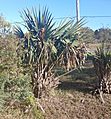Dwarf palmetto facts for kids
Quick facts for kids Dwarf palmetto |
|
|---|---|
 |
|
| Scientific classification | |
| Genus: |
Sabal
|
| Species: |
minor
|
| Synonyms | |
|
Synonymy
Corypha minor Jacq.
Sabal adansonii Guerns. Chamaerops glabra Mill. Corypha pumila Walter Rhapis arundinacea Aiton Chamaerops acaulis Michx. Sabal caroliniana Poir. Rhapis acaulis (Michx.) Walter ex Willd. Chamaerops arundinacea (Aiton) Sm. Chamaerops louisiana Darby Sabal adiantina Raf. Sabal pumila (Walter) Elliott Sabal minima Nutt. Chamaerops sabaloides Baldwin ex Darl. Brahea minima (Nutt.) H.Wendl. Sabal glabra (Mill.) Sarg. Sabal deeringiana Small Sabal floribunda Katzenstein Sabal speciosa L.H.Bailey Sabal louisiana (Darby) Bomhard |
|
The dwarf palmetto (Sabal minor) is a small type of palm. It grows naturally in the southeastern and south-central United States. You can also find it in northeastern Mexico. This palm likes many different places to live. It grows in forests near the sea, in wet swamps, and in areas that flood. Sometimes, it even grows in drier spots. It often likes soil that has a lot of calcium. The dwarf palmetto is special because it can handle cold weather very well. It is one of the toughest palms in North America when it comes to frost.
Where It Grows
The dwarf palmetto grows along the Atlantic Coast. Its natural home stretches from central Florida up to Monkey Island, North Carolina. Along the Gulf Coast, it grows from central Florida to central Texas. You can also find it in Arkansas, southern Oklahoma, and northern Alabama. Further south, it grows in the state of Nuevo León in Mexico.
What It Looks Like
The dwarf palmetto can grow up to 3 meters (about 10 feet) tall. Its trunk can be as wide as 30 centimeters (about 1 foot). It is a fan palm. This means its leaves look like a rounded fan. Each leaf can be 1.5 to 2 meters (5 to 6.5 feet) long. They have about 40 smaller parts called leaflets. These leaflets can be up to 80 centimeters (31 inches) long. They are joined together for more than half their length.
The flowers of the dwarf palmetto are yellowish-white. They are small, about 5 millimeters (0.2 inches) across. These flowers grow in large bunches up to 2 meters (6.5 feet) long. These bunches stick out beyond the leaves. The fruit is a black, round fruit. It is about 1 to 1.3 centimeters (0.4 to 0.5 inches) long. Each fruit holds one seed inside.
How People Grow It
The dwarf palmetto is one of the most cold-hardy palms. This means it can survive very cold temperatures. However, it grows best in hot and humid summer weather. It might grow slowly in places with cool summers. Its leaves can handle temperatures close to 0 degrees Fahrenheit (about -18 degrees Celsius). It has even survived short times at -5 degrees Fahrenheit (about -20 degrees Celsius). People usually grow it in warm areas.
This palm can grow in many different types of soil. You can often find it in swamps in the southeastern United States. It grows well in both full sun and shady spots. In cooler garden areas (like USDA Zone 7 and below), it does best in full sun. It also likes a spot protected from strong winds.
Since the 1960s, people have started growing Sabal minor in more places. On the East Coast of the United States, it is grown from Florida up to coastal Connecticut. On the West Coast, it grows from Vancouver in Canada down to San Diego. The Virginia Cooperative Extension suggests it as a good plant for gardens.
There are different types, or cultivars, of dwarf palmetto. Some come from the Outer Banks of North Carolina. These are the ones that grow furthest north. Others come from Oklahoma and Texas. One popular type is called 'McCurtain'. It is named after McCurtain County, Oklahoma, where it grows naturally. These 'McCurtain' palms usually stay smaller and do not grow a trunk. The dwarf palmetto is a popular palm for landscaping. You can see it in coastal resort areas from Virginia Beach, Virginia, to southern Texas.
Gallery
Images for kids
-
Dwarf palmettos (Sabal minor) at Palmetto State Park, Texas USA (2 June 2007)
-
Sabal minor and resurrection fern (Pleopeltis polypodioides) growing on oak limb, Big Thicket National Preserve, Hardin Co. Texas, USA (23 October 2019)
-
A dwarf palmetto frond Congaree National Park, South C, USA (8 November 2008)
-
Sabal minor and Needle Palm, also from the southeast, are the world's most freeze hardy palm species.
See also
 In Spanish: Sabal minor para niños
In Spanish: Sabal minor para niños











